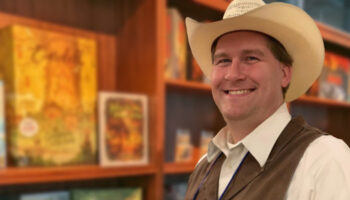Funko Games’ Deirdre Cross and Josh Manderville talk Jurassic World, E.T. and designing legacy games

This year is a big one for NBCUniversal, with E.T. celebrating its 40th anniversary and the latest instalment in the Jurassic World franchise landing in cinemas with Jurassic World: Dominion.
It’s also a big year for Funko Games, and the firm has both bases covered – with E.T. The Extra-Terrestrial: Light Years From Home bringing the classic Spielberg film to the tabletop, while Jurassic World gets the legacy game treatment in Jurassic World: The Legacy of Isla Nublar.
We spoke with Deirdre Cross, VP at Funko Games, and Josh Manderville, Art Director at Funko Games, to find out more about the design process behind these two new titles.

Guys, it’s always great to connect. Let’s dive straight into some of your new games… E.T. The Extra-Terrestrial: Light Years from Home.
Deirdre Cross, VP, Funko Games: Yes, we’re very excited to be partnering with Universal again, this time celebrating E.T. The Extra-Terrestrial and the 40th anniversary of a film that we all grew up with. It really holds a special place in our heart, and we were excited to get the opportunity to bring it to the tabletop so that fans and their families can immerse themselves in this great story.
Had an E.T. game been on the bucket list for a while?
DC: Yeah! We make a lot of licensed games and we have a soft spot for Eighties cinematic adventures. E.T. had been on my list for a very long time, I don’t know about you Josh?
Josh Manderville, Art Director, Funko Games: Yes, I’m a huge Amblin fan in general. Working on games for The Goonies, Back to the Future and this have been dream projects for me. And E.T. is interesting because it is very much a Spielberg film, but it also feels like quite a personal piece for both him and fans. There’s a lot of heart in the film, and capturing that in the game was a challenge, but I’m very proud of what we’ve created.
The art style for this game feels inspired by those classic Eighties movie posters. Was that the inspiration?
JM: The automatic ‘go to’ for inspiration is the movie posters – and the Amblin art, especially the work of Drew Struzan. Universal shared a lot of his watercolour art with us and it was beautiful. So it was about trying to find artists who work in that kind of traditional style, which is tough because most artists work digitally these days.
 Also, we look at the era in which these movies were created. With the Eighties, people think of neon and VHS tapes, but that stuff came in towards the end of the Eighties. In the early Eighties, there was still a lot of bleed over from the Seventies, so you had a lot of watercolour and warm, earthy palettes.
Also, we look at the era in which these movies were created. With the Eighties, people think of neon and VHS tapes, but that stuff came in towards the end of the Eighties. In the early Eighties, there was still a lot of bleed over from the Seventies, so you had a lot of watercolour and warm, earthy palettes.
I actually looked at a lot of Atari boxes and Atari artists like Cliff Spohn and Rick Guidice. E.T. is also one of the most notorious video games of the Eighties, so it made sense to glean something artistically from it! We ultimately wanted to create a look that was true to the film and true to the era.
 And Deirdre, this is another example of you guys taking a mainstream beloved IP and incorporating tabletop game mechanics. How do you walk that tightrope between creating something that pleases E.T. fans and tabletop fans, without alienating those new to these kinds of games?
And Deirdre, this is another example of you guys taking a mainstream beloved IP and incorporating tabletop game mechanics. How do you walk that tightrope between creating something that pleases E.T. fans and tabletop fans, without alienating those new to these kinds of games?
DC: ‘Alienating’ – I see what you did there!
Ha! Finally, I’m appreciated!
DC: Ha! Well, anytime we’re translating a film to the tabletop – especially if it has this kind of legacy – we think about people who maybe haven’t played anything new since they learned Clue 30 years ago. We want to make sure the rules are very straightforward – and that includes the incredible work that Josh does on the layout and design of the rules.
We try to make the process around getting started very simple. In our set-up for the game, it goes through the set-up of the components and then it says ‘now watch this video on how to play.’ You can read the rest of the rulebook, or you can consult it after you watch the short video. We look for ways to get people in as fast as possible.
We also have a leg up when it comes to teaching people a new game mechanic they may have never played before by closely tying the mechanic to the story. Our game is based around the scene when the kids are dashing to get E.T. to the clearing to get him home.
By basing our game on this beloved scene, you understand your motivation and why you’re doing what you’re doing in the game. As long as we’re true to that, and we make the right decisions for each story, it helps make it easier for new people to play the game, especially if they’re coming to this just because they love E.T.
 You guys make everything from light card games to big box games. What dictates where you go with a brand? Why go down this route for an E.T. game versus a party game, for example?
You guys make everything from light card games to big box games. What dictates where you go with a brand? Why go down this route for an E.T. game versus a party game, for example?
DC: In this case, Universal specifically wanted a Prospero Hall-style game. They thought we did a beautiful job with Back to the Future so they wanted another game where fans could really sink into the world and the story of the movie.
 With E.T., where there any tough nuts during the development process that you’re especially proud to have cracked?
With E.T., where there any tough nuts during the development process that you’re especially proud to have cracked?
DC: E.T. is the original ‘kids on bikes’ film, so we knew we needed to include that in some way, but we needed to make the bikes consequential. So in the game, there’s an E.T. piece that fits into the kids’ baskets. He can fit into any bike’s basket, and the bases of the bike pieces actually fit together.
We thought: ‘If they have E.T. with them, they should be able to fly, right?’ So in the game, if you have E.T. with you – either solo or together as a group – you can fly around the board. It wasn’t enough to have a cardboard mover – we wanted a 3D piece that could carry E.T. and bring the story viscerally to life.
And Josh, were there any tricky problems to solve on the art side of things?
JM: The bike sequence in the movie starts at dusk and ends at night, with the spaceship landing in the forest. So, in our game, we couldn’t have the spaceship land in daylight, and we couldn’t have kid riding their bikes at night… That was a problem to solve!
And what was the solution?
JM: With the watercolour art being a transitional colour palette, we were able to start players in daylight and end the game at night in the forest. You get that transition as you play. We had to make it feel immersive, organic and game-y.
Of course! That’s a very smart, stylish solution. It looks great. Now, while I’ve got you, I also wanted to ask about your upcoming legacy game, Jurassic World: The Legacy of Isla Nublar. For anyone that hasn’t seen this yet, what do they need to know?
DC: Jurassic World: The Legacy of Isla Nublar is coming to Kickstarter on March 22nd. This game is a legacy game that starts before the first Jurassic Park film. You get to build the park how you would like, before playing through the entire Jurassic World franchise. You’ll find out if you’d make better decisions than the people in the films!
It takes place over 12 legacy adventures, and the grand finale is endlessly replayable. Oh, and each story takes around two hours to play, so you get between 24 and 30 hours of legacy adventures to play through.
 Amazing. Why opt for Kickstarter?
Amazing. Why opt for Kickstarter?
DC: Well, we’ve worked on Jurassic Park games in the past, with games like Funkoverse: Jurassic Park, so this is a sandbox we can’t stay away from! When we had the opportunity to talk with Universal about making a legacy game, we knew we wanted to make it big – but we had no idea how big it would become!
Once it started to reach a certain scale, we realised we needed to go to Kickstarter to have that conversation with the consumer about what’s in this game and how awesome it’s going to be.
 Josh, the art of this game doesn’t look like any sort of movie poster. What direction did you opt to go down for this?
Josh, the art of this game doesn’t look like any sort of movie poster. What direction did you opt to go down for this?
JM: I should start by saying I’m not the art direction lead for this game, but I had plenty of input. We started by tapping into old issues of Scientific American, adventure magazines, and certainly movie posters too. The result was a game that has a distinct 1950s pulp fiction vibe but is also uniquely its own.
DC: In addition to the inspiration from fictional materials, the game’s board is inspired by Hawaiian tourism pamphlets and maps from the same era. As our designer Jordan Christianson likes to say — we wanted the game to feel like you just unearthed a dead stock game from the mid-century, found buried in your grandparents’ attic. It’s an unopened treasure and a time capsule of sorts.
 Designing a legacy game sounds like a bit of a mind-melting experience, with all the different decisions and directions you have to map out. How was the development process?
Designing a legacy game sounds like a bit of a mind-melting experience, with all the different decisions and directions you have to map out. How was the development process?
DC: We started work on this well before the pandemic, and it’s been a very interesting process. There’s lots of playable characters that come in and out, and the duration of the project ensured we could really explore all the threads we wanted to include. Then we played it and played it and played it.
With something like our E.T. game, you play it, make a change and then play it again. With this game, you change something and it’s just like Ian Malcolm says in the film: “A butterfly can flap its wings in Peking and in Central Park you get rain instead of sunshine.” We’d flap our wings in chapter one of the game and chapter 12 would go crazy!
It was an exhaustive, exhausting design process and the design team left it all on the field; it’s fantastic.
 Was another benefit of the legacy format that you could give all the iconic moments from across the entire franchise movies their time in the sun?
Was another benefit of the legacy format that you could give all the iconic moments from across the entire franchise movies their time in the sun?
DC: Yes, that’s very true. The way the game is engineered, there are key events that come out in every chapter. Some are things you’d expect: problems with the fences, an escaped T-Rex… So yes, we can shine a spotlight on those things, but you’re making different decisions than what they make in the film.
So when the power goes out, your T-Rex might not escape because you might’ve reinforced the fence! Your story may play out very differently.
 So there’s a chance that, through certain decisions, I could play the game and Jeff Goldblum keeps his shirt on?
So there’s a chance that, through certain decisions, I could play the game and Jeff Goldblum keeps his shirt on?
JM: Well once its off, it’s off for the entire game! It’s a legacy game!
He’s going to be absolutely freezing!
DC: Ha! Look, it’s a legacy game, I’m not going to spoil anything!
Yes, don’t ruin anything! Guys, as always, this has been fun. Good luck with the Kickstarter campaign, and with the launch of E.T. The Extra-Terrestrial: Light Years From Home. Let’s catch up again soon!
–
To stay in the loop with the latest news, interviews and features from the world of toy and game design, sign up to our weekly newsletter here





















